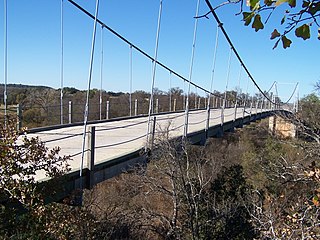The Wisconsin Bridge and Iron Company (WB&I) was a fabricator and erector of iron and steel bridges and other large structures.
These historic properties and districts in the state of Texas are listed in the National Register of Historic Places. Properties and/or districts are listed in most of Texas's 254 counties.
Luten Bridge Company and variations such as Luten Engineering Company was the name of a number of different bridge building companies in the United States during the early- to mid-20th century. Each had rights to build concrete Luten arch bridges, according to the patented designs of Daniel B. Luten, of Indianapolis.
The Kansas City Bridge Company was a bridge building company that built many bridges throughout the Midwest United States in the early 1900s. The company was founded in 1893 and ceased business around 1960.

The King Iron Bridge & Manufacturing Company was a late-19th-century bridge building company located in Cleveland, Ohio. It was founded by Zenas King (1818–1892) in 1858 and subsequently managed by his sons, James A. King and Harry W. King and then his grandson, Norman C. King, until the mid-1920s. Many of the bridges built by the company were used during America's expansion west in the late 19th century and early 20th century, and some of these bridges are still standing today.

Highway 289 is a designation for two north–south state highways in north central Arkansas. A southern route of 4.93 miles (7.93 km) runs north from Highway 69B (AR 69B) at Sage to Zion. A second route of 37.89 miles (60.98 km) begins at Highway 56 in Franklin and runs north to Highway 9 in Mammoth Spring.

Canton Bridge Company was a firm that was later incorporated into the American Bridge Company. The firm was established in Canton, Ohio in 1892 and became one of the nation's biggest bridge-builders during the early 20th century. It designed and/or built many bridges that later became listed on the U.S. National Register of Historic Places (NRHP).

The Pueblo Bridge Co. is a firm that built a large number of bridges in the United States. Several are listed on the U.S. National Register of Historic Places.

The Missouri Valley Bridge & Iron Co., also known as Missouri Valley Bridge Company, was a engineering, construction, and steel fabrication firm that operated through the late nineteenth and most of the twentieth centuries. It was based in Leavenworth, Kansas, with a WWII facility in Evansville, Indiana.
Topeka Bridge & Iron Co. was a bridge company. Its works include many bridges that are now listed on the U.S. National Register of Historic Places. Its Canyon Diablo Bridge was a concrete Luten arch bridge built in 1914. Its Amelia Park Bridge, for another example, was built in 1914.
Fargo Bridge & Iron Co. was a bridge company based in North Dakota in the early part of the 20th century.

The Vincennes Bridge Company, based in Vincennes, Indiana, was a designer and builder of bridges that was "one of Indiana's 'most successful bridge-building firms'".

George Herndon Pegram (1855–1937), most commonly known as George H. Pegram, was an engineer who patented the Pegram truss.

The Groton Bridge Co. was an American construction company.

Monarch Engineering Co. was an American firm of Denver, Colorado, active in engineering and construction services. John A. Crook and his brother, Guy A. Crook of Falls City, were founders of the Monarch Engineering company which had its origin and main offices at Falls City, with offices in Kansas City, and Denver. Under the management of these men the Monarch Engineering company had risen to become an important and prosperous concern and a vast amount of bridge construction, city paving, irrigation-dam building, and public building work has been done under their supervision. Within ten years after the firm had been in operation, or since 1908, its activities constantly increased and in 1917 they purchased the Denver Steel and Iron Works in order to facilitate the material supply part of the construction work in which they were engaged.

The Illinois Steel Company was an American steel producer with five plants in Illinois and Wisconsin. Founded through a consolidation in 1889, Illinois Steel grew to become the largest steel producer in the United States. In 1898, several other steel and transportation companies were merged into it to form the Federal Steel Company, itself merged into U.S. Steel in 1901.

The Pittsburgh-Des Moines Steel Company, and often referred to as Pitt-Des Moines Steel or PDM was an American steel fabrication company. It operated from 1892 until approximately 2002 when its assets were sold to other companies, including Chicago Bridge & Iron Company. The company began as a builder of steel water tanks and bridges. It also later fabricated the "forked" columns for the World Trade Center in the 1960s, and was the steel fabricator and erector for the Gateway Arch in St. Louis. A number of its works are listed on the National Register of Historic Places.
The Illinois Steel Bridge Company was an American manufacturer of bridges based in Jacksonville, Illinois. It is credited as builder of a number of bridges and other structures that are listed on the National Register of Historic Places.

The AR 289 Bridge Over English Creek is a historic bridge in rural eastern Fulton County, Arkansas. The bridge, a single-span steel Pratt through-truss structure, carries Arkansas Highway 289 over English Creek south of Mammoth Spring. The span is 122 feet (37 m) long and 20 feet (6.1 m) wide, and rests on concrete abutments. Built in 1929 by the Virginia Bridge and Iron Company, it is important as a well-preserved example of its type in Fulton County, and for its historical role in transportation in the region.

Austin Bridge Company was a bridge company based in Dallas, Texas. It fabricated and built a number of bridges that are listed on the U.S. National Register of Historic Places. It eventually became part of Austin Industries.













